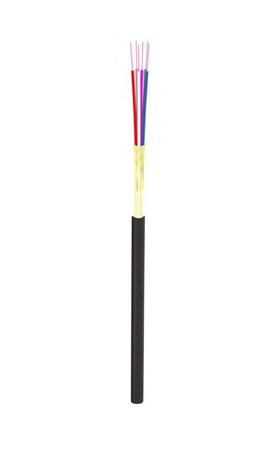48FO (12x4) Riser Flex Tube Fiber Optic Cable SM G.652.D Black
Product Details
Cablescom
EE5493F00004800NO
TP023809
MS 48F 12T04F G2D FVP-2 CCZ
New
Similar Products
Product Description
The 48FO (12x4) Riser Flex Tube Fiber Optic Cable SM G.652.D Black (Part number: EE5493F00004800NO) from Cablescom with 48FO. Riser fiber optic cable is used in indoor and outdoor optical networks, more specifically in LAN backbone, access and riser zone. Riser cables are being used more and more in big projects outdoor that's why this type of cable benefits from a special jacket for different necessities.
The 48FO (12x4) Riser Flex Tube Fiber Optic Cable SM G.652.D Black from Cablescom is a Riser cable with 48 fibers within 12 flex tubes. This ultra-compact optical fiber cable has a micromodule structure (flex tube construction) with small OD, a polyethylene sheath and fiber glass reinforcements, allowing easy installation in canalization buildings. The optical fibers comply with ITU-T recommendations G.652.D.
Applications
For indoor use; Installation in buildings canalizations.
Characteristics
- Optical fiber
- Singlemode
- Flex tube
- Dielectric
- Metal-free
- RoHS compliant
- High flexibility
- Exterior Diameter of cable 7,8 mm
- Weight 39 Kg/km
Product Specifications
Fiber Type (ITU) - OS2 G.652.D
Each type of single-mode fiber has its own area of application, and the evolution of these optical fiber specifications reflects the evolution of transmission system technology from the earliest installation of single-mode optical fiber to the present day. Choose the right fiber is very important for each project/installation. The specification of the OS2 fiber is generally considered as the SMF standard for the single-mode fiber. For the OS2 G.652 fiber there are 4 subcategories: G.652.A, G.652.B, G.652.C, G.652.D.
The OS2 G.652.D single-mode fibers are the most used type of fiber for networking and communications applications. The OS2 G.652.D fiber type provides a zero dispersion at 1310nm wavelength therefor it is optimized for operation in the 1310nm Wavelength. The regular performance remains on the 1550nm wavelength.
Benefits of using the OS2 G.652.D fibers:
- Backward compatibility with earlier versions;
- Lower system cost;
- Offers zero water peak and seamless splicing;
- Lower splicing losses;
- Supports longer cable runs.
FOC Construction - Flex tube
While using a flex tube construction in cables, you can:
- Reduced installation time;
- Easier handling, particularly in fiber distribution and termination units;
- Fast access to fibers; easy to remove the module material with no tools required;
- Small quantity of grease, minimizing clean-up time;
- Avoid the risk of tube kinking (potentially causing attenuation increments or fiber breakage);
- Simple mid-span breakout enabling single module extraction to aid distribution.
The cable flex tube construction solution can be chosen for the following applications:
- Direct buried;
- Rodent resistant;
- Gunshot resistant;
- Facade;
- Indoor and outdoor;
- Hybrid;
- Underwater;
- Tunnel.
Fiber Mode - Single Mode (SM)
Single mode fiber uses a LASER light source, is a type of optical fiber with a small core diameter that allows only one mode of light to propagate. It is used in telecommunications and data transmission systems to transmit signals over long distances with low attenuation and high bandwidth. Single mode fiber is ideal for high-speed and long-distance applications, such as internet backbone networks, cable television networks, and fiber-to-the-home (FTTH) services. Its narrow core reduces the dispersion of light, allowing signals to travel further and faster than with multimode fiber.





.png?locale=en)



















